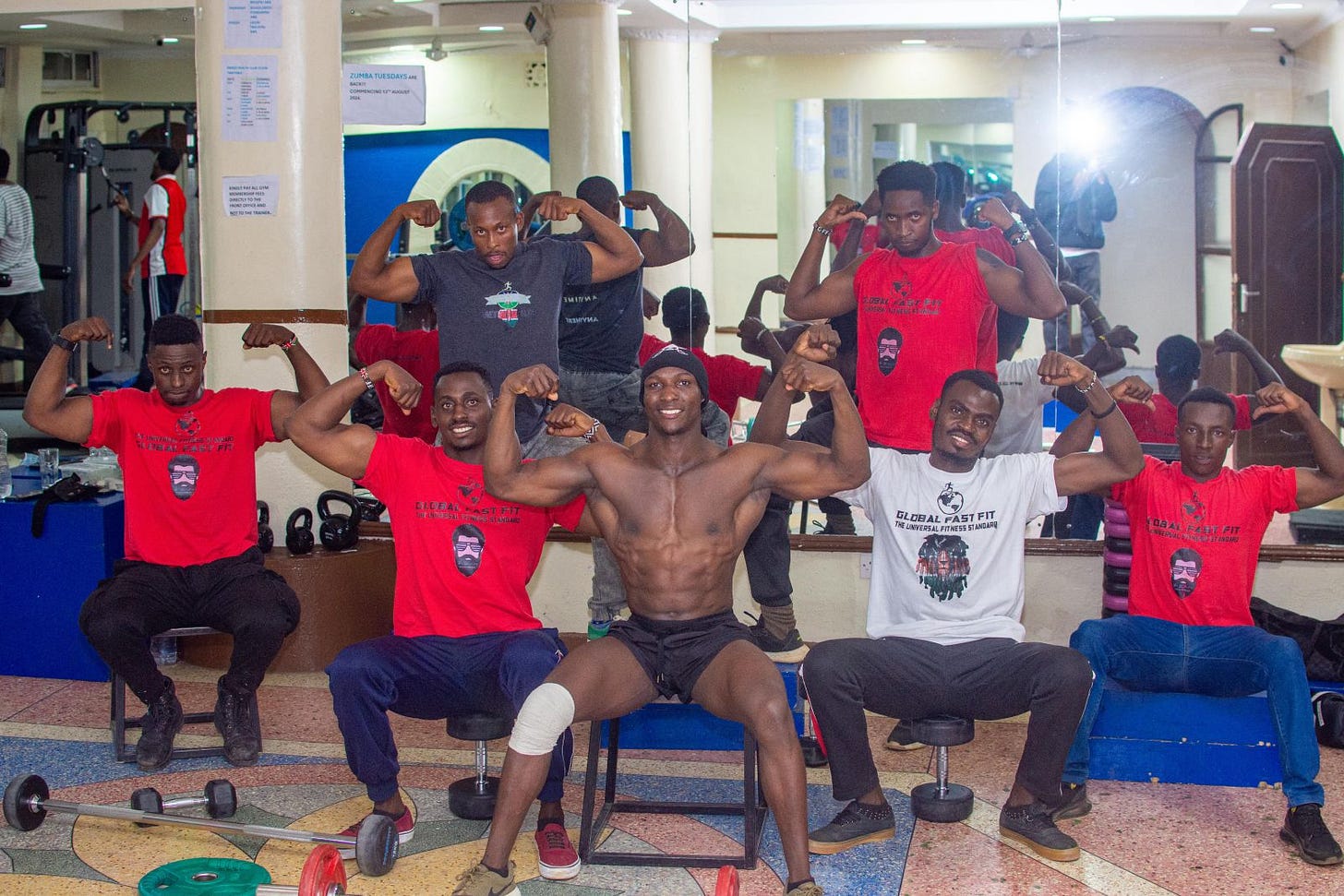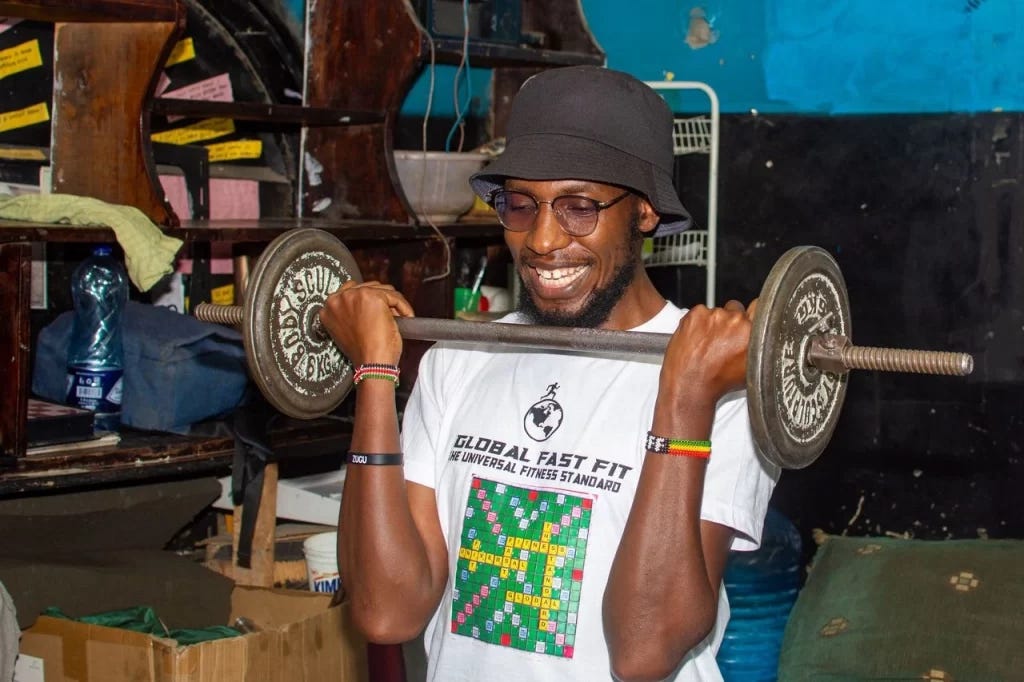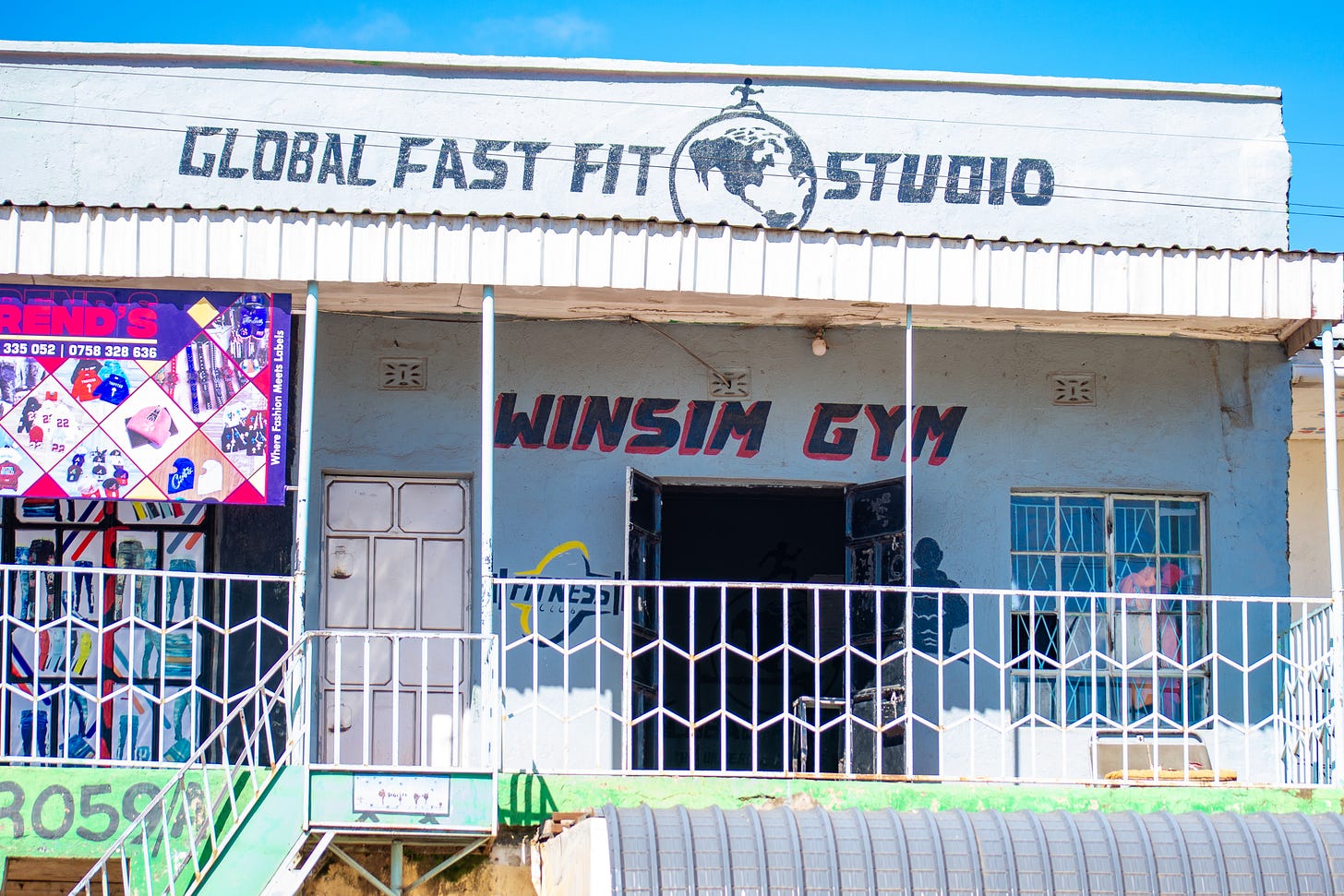
BREAKING NEWS! Global Fast Fit and Nyandarua County Ministry of Youth and Sports Affairs Collaborate on Future of County Athletics
S. Sean Suvanadesa , Thailand Nov 17, 2025

A Message from Global Fast Fit about Concussions and CTE Awareness
S. Sean Suvanadesa , Thailand Oct 18, 2025
With more boxers and MMA fighters finding their way to Global Fast Fit, we'd like to take the opportunity to cover an important topic related to combat sports. We admire all athletes, period. However, there's a prevalence of acute and chronic injuries that occur with those involved in sports that incur frequent head trauma. Our global health initiative promotes living a fit and healthy lifestyle to combat problems such as type 2 diabetes, and heart disease, but we aren't limited to issues caused only from poor dietary habits and sedentary behavior. Global Fast Fit is about longevity. It's about living the most fulfilling and active life that you can possibly have, void of avoidable pain as you move onward into your twilight years. So here are a few things that we'd like to help both up and coming, as well as veteran fighters avoid.
Concussions and Chronic Traumatic Encephelopathy (CTE)
What may immediately come to mind when discussing sports where concussions are common and frequent is chronic traumatic encephelopathy (CTE). The brain is encased within the most protective structure within your body, but it doesn't mean that it's impervious to physical trauma. Your brain is suspended within your skull in cerebrospinal fluid, floating there as it manages the various processes that go on in your body. When you receive a physical blow to the head, the brain collides with the skull as it's shaken from its suspension. Those blows are what lead to concussions as the nerves and blood vessels in the brain become damaged from the trauma. While concussions may not be life-threatening, frequent concussions can lead to something far more debilitating like CTE.
Acute brain injuries resolve themselves over time. A person dealing with a concussion will display symptoms like brain fog, headaches, confusion, nausea, tinnitus, etc. These problems can eventually lessen and dissipate with the right treatment and rest as the brain devotes energy into healing itself. However, with constant head injuries, some of these symptoms may persist, along with a slew of others issues like behavioral changes, executive function loss, issues with movement, etc. If these types of problems become chronic and persistent over time then it's possible that CTE has already begun to develop and differing types of therapies are required to address the various issues that come with it.
We've witnessed multiple boxers and MMA fighters who have dealt with acute and chronic brain injuries like CTE. The most famous being Muhammad Ali and his development of young onset Parkinson's Disease, which he was diagnosed with in 1984. While specialists treating Muhammad Ali's Parkinson's Disease believe that his development of the disease was idiopathic (meaning the cause of it is unknown), it certainly couldn't have helped that his career involved being constantly punched in the head. Other notable boxers and MMA fighters who deal with CTE are:
Wilfred Benitez: A former boxing world champion that lost his ability to speak and is confined to a bed due to CTE
Spencer Fischer: An MMA fighter that was diagnosed with dementia after his brain scans showed significant brain damage
Nam Phan: An MMA fighter who is now facing speech degradation after retiring
While boxers and fighters may not be able to avoid the frequent blows to the head, they can keep in mind that problems like this exist and take the necessary precautions during training as well as after their fights. Both vigilance and awareness go a long way in ensuring that if there are any potential problems from these types of contact injuries, that they get the immediate care and treatment as needed. So please protect yourself both inside and outside the ring so you can live the fulfilling life that we know you deserve to have.

The Ongoing Search for the Fittest East Africans: Fighter Edition
S. Sean Suvanadesa , Thailand Oct 10, 2025
Last time in our search for the fittest East Africans, we found ourselves in the underground Kenyan bodybuilding scene. Kenya, known for producing the best marathon runners in the world, also happens to have some budding bodybuilders too. Kenya isn't as well-known for the art of bodily aesthetics, and it's still very much a work in progress. Still, it has a very promising future with young Kenyan bodybuilders receiving mentorship from industry veterans like Gachau Njoroge. With that said, where could our search for the fittest East African possibly take us next?
If you've been keeping up with our content, you'll see that we are sponsoring a young Ugandan up and coming boxer aptly named, Brenda "Ring Beast" Muduwa. Brenda is an absolute force to be reckoned with, her tenacity in the ring is unmatched, and that's because of the considerable amount of time she puts in the gym. This isn't just about the time she allocates towards honing her craft, but also honing her level of fitness. Boxers without good cardiovascular fitness won't make it far in any league. It won't matter how strong you are, if your goal isn't to always KO your opponent seconds into a match after the bell rings, then you better not gas as the round/match drags on. Something we also like about Brenda is that her time and work honing her physical strength has also allowed her to overcome an issue that plague many women worldwide, and that's developing upper body strength. She can pump out unassisted pushups and pull-ups without issue, a feat that we've noticed is uncommon among females.
Boxers need to have a unique set of physical strengths and attributes to make them as fit as they need to be for their profession, but what about other fighters? We've come across another impressive Ugandan fighter named Annet "Rose" Kiiza, representing Africa Top Team Uganda. Annet isn't just an ordinary fighter, she's a multi-disciplinary athlete who has a background in Muay Thai, Taekwondo, BJJ, wrestling, and so on. She's already had professional fights in four sided, and eight sided rings, and is highly decorated at a very young age. Annet exemplifies having the physical tools necessary for being a multi-discipline fighter. Strength isn't the only component for the aforementioned styles (though it's certainly helpful), but having a combination of agility, mobility, and flexibility is the only way to reach the next level in those martial arts. An immobile mixed martial arts fighter is an ineffective one, whether they're throwing high kicks, or being contorted while in guard position, MMA fighters must be capable of moving quickly and explosively without the fear of causing themselves injury.
So not only do we have two incredibly impressive well-rounded top contenders for fittest East African, but also incredible role models for women, worldwide. We congratulate both Brenda and Annet on their accomplishments, and can't wait to see what the future holds for them (obviously more gold)!
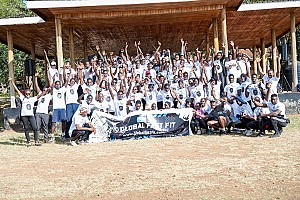
Is Global Fast Fit just a Fitness Routine?
S. Sean Suvanadesa , Thailand Oct 02, 2025
Anyone who's been following Global Fast Fit will have at least caught wind of the GFF Standard Routine.
15x Pushups
15x Plank Leg Lifts
15x Bodyweight Squats
250m Run
The Standard Routine consists of the above exercises being done in succession with as little break in between in order to achieve the fastest time possible. A noble measuring stick of the the upper and lower body, core strength, cardiovascular health, and overall agility.
The organization's tagline is the Universal Fitness Standard, in order to showcase its ability to quickly gauge one's physical fitness through the above routine.
The other tagline is Anyone, Anytime, Anywhere, because literally anyone can do the routine, whether you've never exercised in your life, or if you're a career athlete. It can also be done whenever and wherever you feel like doing the routine since you don't need any equipment, and all the physical resistance you need is created through your own bodyweight.
Is this all Global Fast Fit is? Not even close.
As a growing global health initiative, Global Fast Fit certainly pushes for physical development. One of the stated missions is to combat and work towards eradicating lifestyle diseases like heart disease and type 2 diabetes. However, it isn't limited to only physical development.
Human development is as much a goal as anything else within Global Fast Fit. Physical fitness is just one aspect of that goal. The owner of Global Fast Fit, John F. Groom started this venture as "a way to leave the world a better place than when he entered it". This isn't his only philanthropic venture, but it certainly will be his biggest.
His focus for human development entails creating opportunity, especially in places where there's a deficit. The growing East Africa team consists of a vibrant and eclectic mixture of medical professionals, sports athletes, gym owners, students, trainers, and much much more. Each member has done their part to not just improve the physical well-being of those around them, but to improve the overall quality of their lives.
There are many examples of this:
- Classrooms have been remodelled and revamped
- A general store has been opened to service a community in need
- Students have been provided with the necessary nutrition
- Community workouts and hikes have been organized
- Children were given instruments and training on how to play them
So before you judge Global Fast Fit as just a fitness routine, then think again. There certainly is movement involved for anyone that's participated in or has been affected by this organization and it isn't just 250m forward, but forward in life.
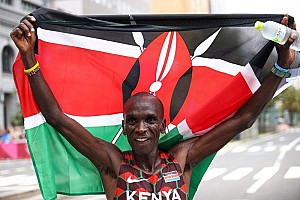
Global Fast Fit and Kenyan Athletic Dominance
S. Sean Suvanadesa , Thailand Jul 23, 2025
It should be no surprise that after the worldwide advent of Global Fast Fit a year and a half ago that Kenyans have no less than dominated. They’ve ranked highest in multiple metrics, which would include but most certainly aren’t limited to adoption, participation in events, fastest time in multiple categories, and much much more.
Kenyans are expected to hold the majority of Global Fast Fit records. Just based off the infographic above considering that out of the 29 countries, and 6,335 participants worldwide, Kenyans hold a staggering 46.2% of participation. Indonesia comes in 2nd with 26.2% and India is 3rd with 18.3%.
Let’s look at the top three performers of the Global Fast Fit Standard routine. We’ve divided the categories to see the top three overall, top women, top men above 50, and top women above 50:
The standard routine is much more accessible in that it only requires half the effort and exertion than that of the pro routine, but you can see that Kenyans under 50 have taken every spot for top three. What about the pro routine?
We can observe less parity in international distribution for the pro routine, but Kenyans still have excellent overall representation, especially when we consider increasing the list sizes to top ten or top fifteen.
But why do Kenyans have so much stake when it comes to athletic events? We had mentioned their dominance in long-distance running competitions in a previous post, but we’re seeing the same level of intensity toward Global Fast Fit.
Performers in any of the Global Fast Fit routines can attest that the running aspect of it is the most considerable factor in achieving a better score. Going too fast on the bodyweight exercises (pushups, plank leg lifts, bodyweight squats) lead to a high percentage risk of disqualification for poor form.
This would make the Global Fast Fit routines more favorable for athletes that are strong runners.
A study by Randall L. Wilber and Yannis P. Pitsiladis asked the same thing when it came to the naturally gifted long-distance running of Kenyan (and Ethiopian) athletes. They listed eight factors as markers for high athletic achievement.
-
Genetic Predisposition
East African genetics allow for higher performance, particularly when it comes to long-distance running.
-
High Maximal Oxygen Intake through Early Age Conditioning
Environmental factors in East Africa condition children to accustom themselves to movement over longer distances through walking or running. This increases their maximal oxygen intake at an early age which lends into adulthood.
-
Higher Hematocrit and Hemoglobin
This indicates the East African body’s ability to more efficiently carry and distribute oxygen throughout the body.
-
Body Type and Composition as well as Lower Limb Structure
The typical East African athletic build tends to be composed of a thinner frame with longer legs. This allows for the body to expend less energy while running and also carry less mass while moving.
-
Favorable Skeletal-Muscle-Fiber Composition
East African muscle fiber compositions tend to be that of slow-twitch fibers which are characterized with having higher oxidative enzymes. This is integral to having an increased aerobic exercise capacity.
-
Diet
A lack of processed foods, starches in every meal, balanced portions, and fresh fruit consumption lend to a diet favorable for runners.
-
Altitude
Some East Africans live and train at a higher altitude. This allows them to be more accustomed to areas where oxygen levels are lower. The body will adapt to areas with lower oxygen by increasing red blood cell production leading to more efficient oxygen distribution and usage.
-
Motivational Factors toward Economic Success
For some, achieving athletic success at the highest level is not only a great honor, but a gateway to a much better standard of living. Being able to compete athletically at an international level allows for greater recognition, and all the rewards that come with it.
Kenyans continue to dominate in Global Fast Fit, and we’re sure they’ll do so for the foreseeable future. Due to their resounding success, we grow more and more intrigued in the utility of the standard, pro, and shuttle routines as a universal fitness benchmark. With all of the aforementioned markers being potential contributors to Kenyan athletic success, and the Global Fast Fit routine’s capability of measuring overall fitness, we strongly believe the combination of the two is in order.
By the end of 2025, we believe we will eventually be able to utilize the Global Fast Fit routines to find the fittest Kenyan living within Kenya.
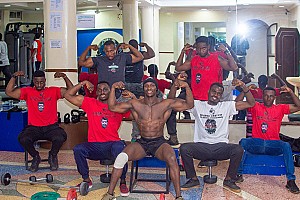
Who are the Nomads? Warriors of Passion that are Changing Nakuru/Nairobi/Kenya One Gym at a Time
S. Sean Suvanadesa , Thailand Jul 17, 2025
The last post was about Winsim GFF Club, what it represented in Nakuru County, and how it emanated and propagated a winning culture and mentality into its community. We also introduced Simon “Kasisi” Ndung’u Mucheru, a no-nonsense man of purpose who has rehabilitated from ORIF (Open Reduction and Internal Fixation) surgery after a harrowing encounter with a raging bull. If you’ve missed it then be sure to give it a read as both Winsim and Kasisi are pillars of the Nakuru community.
Also mentioned in that post is the importance of how Global Fast Fit develops and improves communities starting at a grassroots level. The complexities and nuances of the average day to day life can understandably make it easy to overlook the necessities of maintaining good health. However, being active and healthy (better yet, ‘actively healthy’) to avoid lifestyle disease is a message we intend to hammer home. True understanding of the most minute of personal health issues need to come from the local level, and we can’t go global unless we start local first.
With that being said, as most problems tend to start small, so do most solutions. Winsim GFF Club, with Kasisi heading it is a fantastic start at improving Nakuru County, but how can it be scaled? That’s where the Nomads come in.
The GFF Nomads are a group of young Kenyan fitness coaches that have a passion for being actively healthy, and are taking that passion to the other gyms in Nakuru. What began as a beacon and haven for good health at Winsim, is now a journey and adventure with the Nomads. But who exactly are these Nomads, and why are they the ones to bring active health to Nakuru?
Leading the Nomads is Meshack “Metro” Simiyu, a table tennis player who competes at a national level. Being able to compete at such a high level in any physical activity is indicative of the amount of time and work that comes with perfecting a craft. Metro knows this intimately. He understands the stakes, and that’s why he heads this young group in their quest to empower the community of Nakuru. You can see him sitting second from the right in the front row, wearing the white GFF Kenya t-shirt (get in touch to find out where you can get yours).
Simon “Kasisi” Ndung’u Mucheru, (who you can see furthest to the left in the red GFF t-shirt) you should already be familiar with. He owns and heads the Winsim GFF Club and has taken his ideals of fitness with a purpose out on a road tour with the Nomads. Kasisi is a practical man of faith. The body is a temple, and exercise is a sacrament. His faith was tested when a raging bull’s act of aggression shattered his hip, but with time and conviction he has overcome what for some would be impossible odds. Kasisi is now a Nomad and is a walking display of resilient faith.
Moving toward the right of Kasisi in the back row wearing the dark gray shirt is none other than Kelvin “Rookie” Kairu. His nickname must be an inside joke because he certainly isn’t a rookie in the Global Fast Fit world. Rookie was one of the original members to hold the GFF Men’s World Record back when the pro routine was the standard variation. He’s been around since the early days of Global Fast Fit, and as a GFF Ambassador, has contributed to many of the community projects since their inception. So make no mistake, Rookie is anything but…well, a rookie.
In front of Rookie in the red t-shirt is a man of few words. John “Johnny” Nderitu doesn’t need to say much. Johnny is an accomplished athlete which is easily indicated by his love for swimming, and ridiculously fast Global Fast Fit standard routine time (1:07?!). He’s a common sight on the various treks and hikes that the Kenyan teams take, as Johnny also enjoys a good adventure. His stoic nature adds to the team’s aura and mystique; while Johnny is a man of few words, his actions do plenty of talking.
Behind Metro, to the right in the back row is Simon “Instructor” Muchiri. Instructor is aptly named due to his belief in exercise being the solution for all of life’s problems. He is also one of the masterminds towards Nomad PR, making sure that gyms know of their presence, and eventually, their arrival. Instructor covers the team’s strategic decisions and ensures only smooth operations for the constant travel of this group of trainers.
Furthest right is another former GFF Men’s World Champion, Clinton “CK” Kavai. CK held the record only until recently, but his 1:03 run of the GFF standard routine will stand the test of time. One of the purest athletes of the group, CK exhibits some of the most fluid form and running movement which he has come to be known for. He’s got incredible upside when it comes to the world of athletics and if you’re following the Nomads, a reason to watch would just to see CK meet his potential.
There’s one more Nomad from the original group that isn’t being shown in the above photo…
…so he gets a feature photo all to himself!
Andrew “Zugu” Muchiri is the one documenting the story of the Nomads. Every still and moving media of the Nomads is coming from Zugu. One could argue that Zugu’s work might just be one of the most important coming out of the entire team. Great stories need telling, and that’s precisely what is being done. Every drop of sweat, every exerted effort, is being captured and shown to any who would follow the prodigious Nomads in their journey. Also don’t sleep on Zugu as an athlete, especially when he has a GFF Standard score of 1:28!
So these seven fitness devotees make up the nucleus of the GFF Nomads. And still, you may wonder, what makes the Nomads so special? Surely, trainers that are brought up in the world of health and fitness are expected to dedicate themselves to keeping people in shape? This brings us back to the core message of Global Fast Fit. Getting in shape, becoming healthier, building communities is a choice. While you are not obligated to do so, doing these things makes the world a better place. Each and every one of the Nomads have made this choice. Take their background/career-paths as testament:
Metro: English and Literature
Kasisi: Water Technician
Rookie: Former Rugby Player
Johnny: Automotive Engineer
Instructor: Procurement and Logistics Officer
CK: Electrical and Electronics Engineering
Zugu: Business Management
The Nomads have chosen to create a better life for everyone around them. It doesn’t take a formal education in kinesiology, physical therapy, exercise science, etc. to encourage and influence others to be better. It might need a bit of sweat, probably a lot of time, maybe a few intangibles to overcome, but it starts with a choice.
The Nomads and Global Fast Fit are proud to help you make that choice.
First Nakuru, then Kenya, then the World


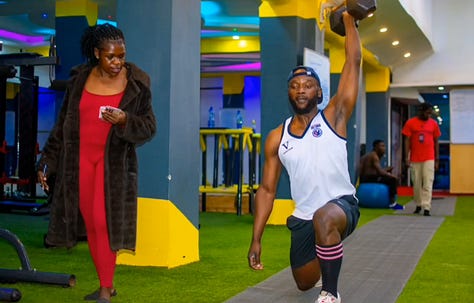

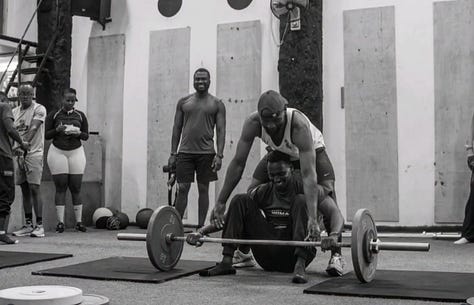
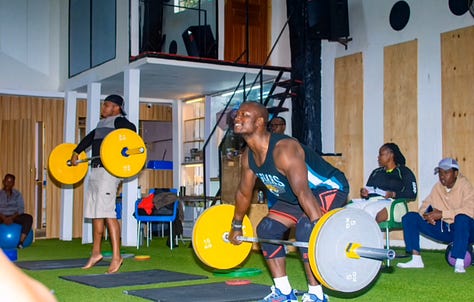
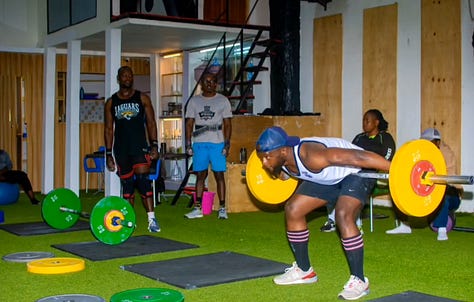
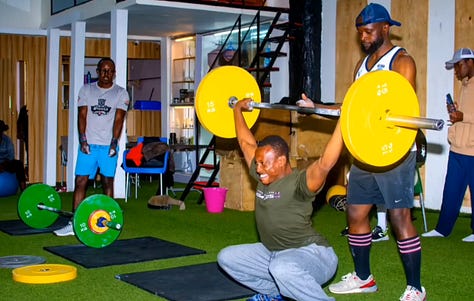


Winsim GFF Studio, a Gym with a Purpose
S. Sean Suvanadesa , Thailand Jul 12, 2025
Today, we bring to your attention the house “Where Warriors Reside”, a gym dedicated toward the values of Global Fast Fit. This place of fitness could be nowhere else other than Winsim GFF Club, located in Nakuru, Kenya.
Kenya is already world famous for its athletes, in particular their long distance runners. Arguably the greatest marathon runner of all time, Eliud Kipchoge, is from Kenya. Other names such as Paul Tergat, Hellen Obiri, Faith Kipyegon come to mind, not to mention the many budding stars rising from the Kenyan ranks.
There’s plenty of buzz and recognition of Kenyans on a global stage, but what goes on at the community level? Despite the name, Global Fast Fit also places extra emphasis and optics on a community perspective. How better to develop individual health & wellness than to target where it all starts?
That’s where the Winsim GFF Club comes in. A gym located in the county of Nakuru, Kenya, just northwest on the outskirts of Kenya’s capital, Nairobi. Winsim instills a no-frills, no-excuses attitude for its goers.
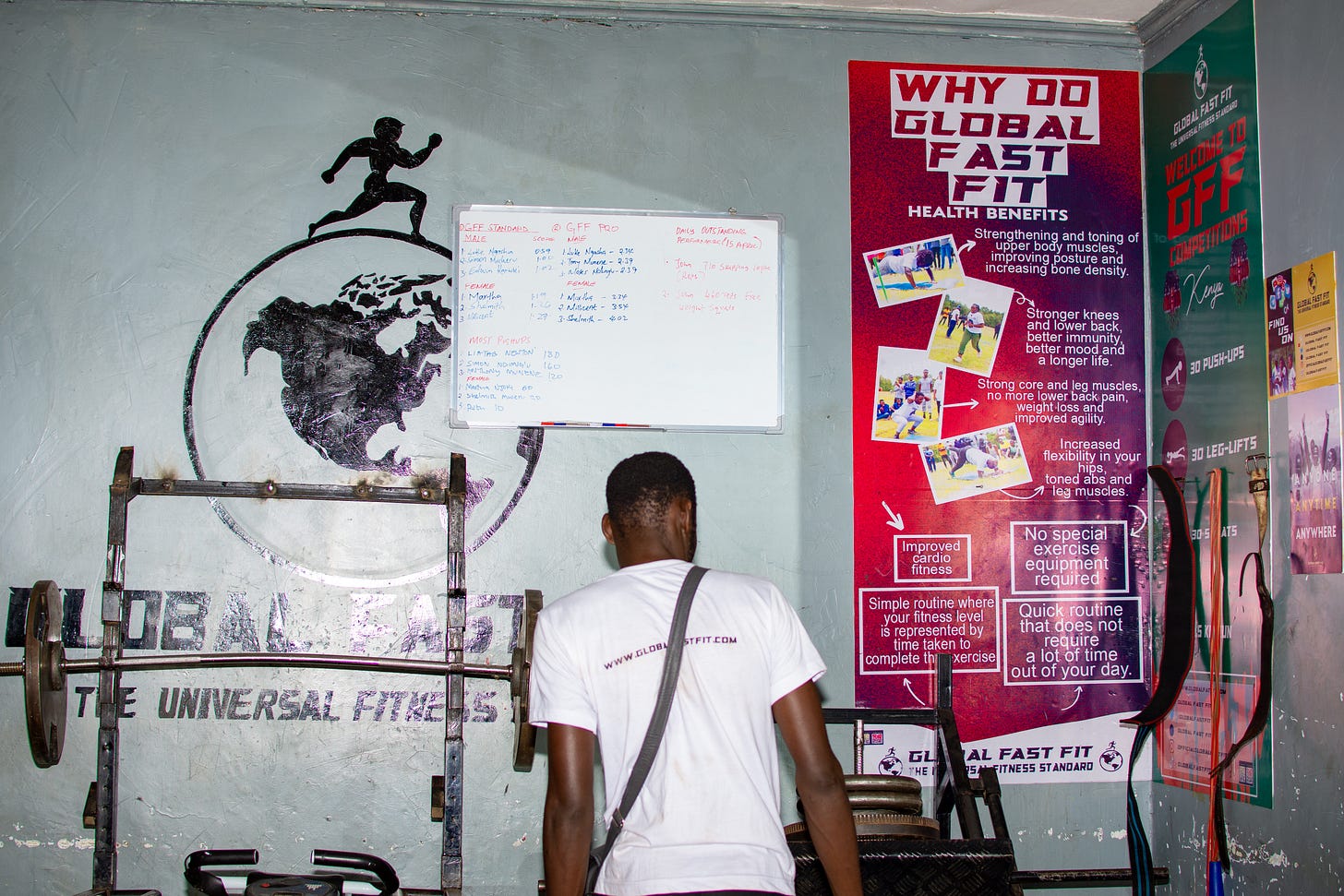
You can envision the exercise culture emanating from this fitness studio. Getting healthy isn’t a luxury, it’s a necessity. Pretty much everything you need is here, and it’s all you really need to get yourself in working shape. The athletes that come out of Winsim aren’t just people who train hard, but they train with a purpose.
There’s a reason for the cultural atmosphere of Winsim GFF Club. Look no further than the proprietor of this fitness studio, Simon Ndung’u, more famously known as Kasisi. Kasisi himself is both a physical outlier and anomaly. See for yourself:

This is the physique of someone who has had ORIF (Open Reduction and Internal Fixation) surgery. That’s when doctors need to realign and fix broken bones through the use of metal plates and screws. It’s quite the feat to be able to bounce back from such a major surgery, but why did Kasisi even need to get ORIF surgery in the first place? He had an aggressive encounter with a raging bull.
Stakes are high, not just in Kenyan communities, but all communities. Staying healthy means continuing to provide for oneself, or one’s family. It means being less of a burden on society throughout the course of your life. For a lot of Kenyan athletes, it could mean a path to the Olympics, or several other high-profile competitions.
So we celebrate Winsim GFF Club and its owner Kasisi, for introducing that culture of purpose to the community of Nakuru. There’s an excellent reason why they were just recently judged as the GOAT gym in a competition with other fitness centers in the region. It’s because this is a gym where exercising has a purpose and that purpose is to win, whether it be in health, in competition, or in life.

Dysautonomia, What is it and Why should you be Worried?
S. Sean Suvanadesa , Thailand May 30, 2025
The Well-Oiled Automaton
Our bodies are absolutely wondrous in every way. Within them are millions of individual cogs that are constantly working and turning to make us the complete living, breathing machines that we are. But what happens when a few of those cogs stop turning? It's nothing too serious, fortunately there are other cogs that can turn harder and faster to pick up the slack, but then what happens when it's no longer a few cogs, but many of them?
The above scenario is a very basic and simple way of explaining what dysautonomia essentially causes. What exactly is dysautonomia, and who of us has this issue?
While you're busy living your life, there are an endless amount of automated processes that your body is conducting that make that living possible. The normal human body knows how much air to take in, how much energy is needed for optimal function, how much waste to secrete, what living and non-living cells it needs to drive out and exterminate, and so on. Because these processes are automated, you won't pay much notice to them because they come effortlessly and naturally. You still probably won't pay too much mind when a few of those functions aren't as efficient as they used to be. They're just issues that begin showing up with age, right?
You'll definitely take notice when those functions no longer operate as intended.
Dysautonomia, and why We've Never Heard of it
Why isn't dysautonomia a more common term in the lay person's medical lexicon? The rarity of very severe cases such as my own is part of the reason, some people can have versions of it that don't impair their day to day life, and really does come off as just issues with getting older.
The other reason we don't hear of dysautonomia is the difficulty in treating it when it gets as severe as it does.
A Frustrating Scenario
Dysautonomia is incredibly difficult to diagnose because conventional medicine dictates that there needs to be hard evidence of bodily dysfunction based off of readings and tests taken at a hospital by a medical specialist. As an example, someone that has frequent and urgent urination of a dark color might be sent to a nephrologist for examination. The nephrologist might take a blood and urine sample and could end up finding elevated creatinine levels within the urine, or perhaps lower blood urea nitrogen. This would potentially indicate kidney, or even possibly liver issues. Despite treatment, and even improved numbers, the problem still persists or possibly even worsens. Maybe the issue is the bladder, so a urinary ultrasound is taken, but no structural problems are detected. The specialist then may refer a different medical department or suggest a wait and see approach seeing as the readings don't indicate a serious issue.
As you're waiting for answers, a few other things begin to go wrong. Along with the urological issues come respiratory issues. Now it takes more effort to take in a full breath of air. A visit to the pulmonologist doesn't reveal anything concrete. General malaise begins to set in as more and more things go wrong little by little over time.
The above scenario represents the dysautonomia conundrum. Something is seriously wrong, but the tests and readings tend to not indicate any immediate solutions.
The problem here is a functional issue as opposed to a structural one.
Structure vs. Function
Structural issues are straightforward, you can determine a problem through a set of readings, then there are solutions to that problem due to the many years of medical science, history, and practice that have gone into solving it. For example, if there's a problem with your lungs then an x-ray, or a tissue sample, etc. may reveal the problem and then there would be a following set of steps in accordance to deal with it.
Functional issues differ because the structure of an organ or system is intact enough that readings and tests appear normal, but somehow they no longer operate optimally or normally. Sometimes a structural problem is found, but resolving it may partially alleviate the dysfunction, or maybe it won't at all.
Why is there an issue? It all happens to do with the body's ability to communicate with the brain and vice-versa. The problem isn't with an organ, or system itself, but rather with the messaging between it and the brain. Once this connection is severed, the part of the body effected by this severance no longer understands the correct way to function.
A common example that can be found with many people that suffer from severe dysautonomia would be the workings of the bladder. The body understands to release the waste contents of the bladder when it's full. It knows when to do it, and you know when it very much requires you to do so. An urge to let out those fluids builds up as the bladder fills, and then there's great urgency to release it when it's completely full in order to make room for more waste. If the connection between the bladder and the brain is severed, then it may no longer understand when is the appropriate time to release all fluids. The bladder might give the sense of urgency to release it at half capacity, or a quarter capacity.
If it's bad enough, it might feel the need to release fluids the moment water enters your body.
I've gone through the above scenario. It's not pleasant to be dehydrated all the time no matter how much water you drink, nor was it fun to lose 5kg (more than 10 lbs.) in a day of water weight. You can also get an idea on how this might affect the day to day life considering that plans have to be made on how to drink fluids, and the proximity you have to be from a restroom at all times.
Who Deals with an Indiscernible Issue?
The primary option for someone suffering from dysautonomia is to visit a functional specialist.
Functional specialists are forced to look at the body as a whole, with all of the aforementioned millions of cogs all turning and working together to keep the human machine running. In order to understand and figure out what's possibly causing the dysfunction, the functional specialist will have to observe the same things a normal medical specialist would such as dietary, and lifestyle habits, but the analysis to treat these issues differ. While they may observe an organ system for clues, they're main goal is to find out the root cause of what's causing the severance in the body's ability to communicate with the brain.
What gives? How does this get dealt with?
In my last post, I announced I'd be revisiting digestive issues and their effects on the human body. Why is a dysautonomia post following it?
While I wish I could give a one size fits all cause for dysautonomia, I can't. The same way that regular medical specialists are unable to, since the source may come from a single problem, or possibly a multitude of them.
However, seeing as my posts tend to deal with the digestive system, I can offer that a common occurrence of these autonomic issues starts in your stomach and works its way from there. Malnutrition and malabsorption of your dietary intake is an easy way for the bodily autonomic functions to begin misfiring over time. Also consider the connection that your gut has with the rest of the body. Your immune system is located there, so is the vagus nerve, which pretty much acts as the information superhighway for all of the signals going to and coming from the brain. People with extended gut problems can easily find themselves in a dire situation once the vagus nerve becomes damaged.
Closing Words
I know there are people out there that are dealing with severe dysautonomia, believe me, I know how bad it can get. If any of you suffering through it happen to stumble upon this blog, just know there's definitely a light at the end of the tunnel. It gets better the moment you find whatever's causing that severance of communication between your body and your brain and deal with it. I've been working on healing through it for four months since the writing of this blog post, and I can definitely say things are moving in the right direction. It's not anywhere close to being fully healed, but at least it's manageable now. There's definitely hope that someday I could one day going back to living a normal life again, and that hope definitely wasn't there before the start of 2025.
For those who want to make sure that dysautonomia never rears its ugly head then eat right and exercise. It's cliche` and said to death but for good reason.

Revisiting the Gut, and Why it Matters
S. Sean Suvanadesa , Thailand May 18, 2025
Anyone who has taken the time to read my past blog posts has gotten some insight on how my severe gastroinstestinal (GI) issues were affecting me both in the past and at the time of the writing of those posts. It's been years of worsening cognitive issues, ability loss, erratic blood pressure, vision and hearing loss, trips to the bathroom every fifteen minutes due to a loose bladder, disassociation, and much much more.
If you've seen my more recent blog posts, then you can see that I've managed to not only stop the symptoms from worsening, but potentially get a chance to reverse them as well. This didn't happen from a regular visit to a hospital. I've seen my fair share of specialists, but conventional treatment and medicine dictate that there needs to be a structural problem for a solid diagnosis. If your readings, x-ray, MRI results come out fine, then there isn't much that can be done, no matter how you feel.
I've decided to revisit this series of posts about GI health, but from a different perspective this time. This is now coming from someone, after years of searching and fighting for having a normal life again, may have finally come across what they were looking for.

In Search of Self Pt. 2
S. Sean Suvanadesa , Thailand Mar 08, 2025 2
What is the soul? The answers to that question seem to vary depending on what time period or culture you derive it from.
Varying Hindu, Buddhist, and Jain sources refer to the soul through the term आत्मन् (Ātman), which can translate to breath, or essence. While the three beliefs have very different perspectives on the nature of Ātman, there is a collective agreement that the soul refers to a sense of self, or being. That the distinction of Ātman requires a form of sentience, where the ability to think and feel are determinant of having Ātman. Another aspect of Ātman (at least from a Theravadan Buddhist perspective) is that it is ever changing, flowing, and ultimately impermanent.
Ancient Greek philosophers of the 5th or 6th century seemed to equate the soul with presence. The soul was referenced through the word έμψυχος (émpsukhos), meaning "animated" or in other words, having life or being alive. There is some irony in the word émpsukhos and it's translation of being animated, as early Greek philosophers like Thales would postulate that inanimate objects capable of animate action (like magnets causing objects to move) could be considered alive, and therefore have a soul.
Christian theology seems to reference the soul in many ways and make clear distinction that it is separate from the spirit, the heart, the mind, and body, but at the same time is in some form or way connected with them all. That it is our permanent material representation and being as we are alive, and our permanent immaterial representation after we depart.
Modern scientific scholars seem to have a different opinion altogether. Freud referred to the soul as the psyche, and how it regulated both our conscious and unconscious thought. Neil Degrasse Tyson stated in one of his interviews that the soul itself didn't exist, and that our sense of being is derived from the neurosynapses of our brain.
Where am I going with this? The title of this blog post is a follow-up to my previous post (https://www.globalfastfit.com/post/in-search-of-self) in which I reference the search for self as a retrieval of one's soul. That the ailments that come from what I now know as dysautonomia (https://thedysautonomiaproject.org/dysautonomia/), strip its bearer of that sense of self through a mental process called dissociation.
The medical help I've received and the lifestyle changes I've made have allowed me to regain some of my working and long-term memory back. More information can be processed with each passing day, and some day to day activities that were once difficult e.g. reading, writing, driving, etc. are now beginning to shift back to normal.
And yet still, one does wonder if the end of this journey to recovery is enough for the solace I seek. Does it return to a point where I can become who I once was? Will I be the same person who enjoyed the things that I did, or are those lost forever? Are they lost because of the illness itself, or the journey it put me through? Is that journey just an aspect of Ātman? Or should I just be thankful that my existence has émpsukhos. Do I have to wait until I depart to get my answer? Or is there nothing in the end, but neurosynapses that just may or may not function effectively again?
One does wonder.
 Login with Google
Login with Google
 Signin with Apple
Signin with Apple
